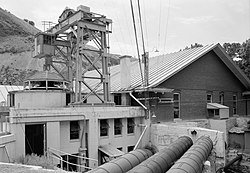Olmsted Station Powerhouse
Olmsted Power Station | |
 Olmsted Power Station | |
| Location | U.S. Highway 189 Provo, Utah |
|---|---|
| Coordinates | 40°18′57″N 111°39′14″W / 40.31583°N 111.65389°W |
| Area | 5.2 acres (2.1 ha) |
| Built | April 12, 1904 |
| Built by | Nunn,L.L.; Nunn,P.N. |
| NRHP reference No. | 72001262[1] |
| Added to NRHP | June 26, 1972 |
The Olmsted Power Station is a historic building located in Provo, Utah. It is listed on the National Register of Historic Places.
Olmsted Station Power House * Off U.S. Highway 189 * Provo, Utah
The Olmsted Station Power House was built in 1904, by L. L. Nunn and his brother and chief engineer, P. N. Nunn. The plant received its name in honor of Fay Devaux Olmsted, who played a key role in helping the Nunn brothers design the plant, contracted and died from Tuberculosis before the plant was completed. The plant, when running at full capacity, was able to provide twelve megawatts of power[citation needed], which is enough for about three thousand homes. Along with the Power station these men established an institute, known as the Telluride Institute, which was home to approximately forty students. This institute was the first corporation sponsored electrical school in the U.S., and continued to operate until 1912 when Utah Power and Light Company attained the property.
History
In order to harvest the power of falling water, new technology needed to be invented. To facilitate this, the Nunn brothers worked with George Westinghouse, hoping he would be able to use falling water to power transformers, switches, and water powered generators. The Nunn brothers provided Westinghouse with a pouch of gold worth fifty thousand gold, and eventually the technology was available so that the plant could be built and become an efficient energy source. The Olmsted power station still provides Provo with power today.
Original Equipment
Although there have been extensions to the original equipment in both 1917 and 1948, the Olmsted Station Power House still retains some original equipment. The original equipment comprises Three general Electric generators (2300 volts), Three Lambard governors, One general electric water driven exciter with Pelton wheel (125 DC volts), Nine general electric transformers (2300–44,000 volts), Nine westinghouse oil switches, One sycrometer, and Four general electric field rheostats.
It was listed on the National Register of Historic Places in 1972; the listing included two contributing buildings on 5.2 acres (2.1 ha).[1][2]
References
- ^ a b "National Register Information System". National Register of Historic Places. National Park Service. July 9, 2010.
- ^ Beall, Burtch W. (December 1971). "National Register of Historic Places Inventory/Nomination: Olmsted Station Power House". National Park Service. and accompanying photos
- Beall, Burtch W. "National Register of Historic Places Inventory - Nomination Form. Historic American Engineering Record. Salt Lake City, Utah. December 1971.
- http://www.heraldextra.com/news/local/central/provo/article_9bec53ca-01d7-5a60-901a-578fde41c1e0.html


